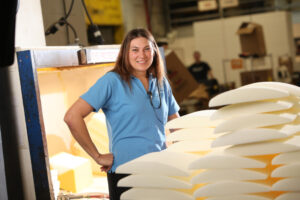
There are many types of foams with each having it own unique properties that make them ideal for one or more applications. Manufacturers must choose the right foam for their products. This selection affects the cost, ease and speed of manufacturing, and overall quality of products.
When it comes to manufacturing seat cushions and other types of commercial and residential seating including mattresses, furniture, restaurant benches, or seating there are several considerations that must be made by manufacturers to maximize the efficacy of their products.
Durability and Resiliency
Seating foam’s most valuable properties are its resiliency and durability. Cushions must be able to suffer years of use. The foam you choose must be able to withstand this pressure without losing its shape, ripping, or otherwise transforming over time. At the same time, manufacturers also need to consider the firmness and density of the foam, which can greatly impact the level of comfort for the user over time. It’s a delicate balance to make, and when manufacturers get it right, they are rewarded with longer-lasting, better quality products.
Anti-Microbial
Whether the seating is being used in a commercial or residential setting, the foam must be highly resilient to bacteria, mold, and other undesirable impacts. This increases the quality and longevity of the products they are used in. Many types of polyurethane and polyethylene foams are antimicrobial and help meet this criteria.
Flame Retardant
Flame retardant foams can help hinder the spread of fires and also stop potential fires from even beginning. For commercial businesses, it may be required by state law to use certain types of flame retardant foam in seating. For residential use, this type of foam can increase a home’s protection against fires. Fire retardant chemicals can be applied to different types of foams as well to give them this unique property.
Choosing Between Closed and Open-Cell Foam
Seat foams and cushioning can be made from polyurethane, which is an open-cell foam, or polyethylene, which is a closed-cell foam.
Polyurethane open-cell foams (like memory foam) are lighter and softer and can easily return to their original shape. They are commonly used in mattresses, pillows and seat cushions.
Poluethylene closed-cell foams are firmer and more rigid, which can make them more durable, tear–resistant, and better at absorbing shocks. However, these benefits tend to come at the cost of less comfort. When used in seating, closed-cell foams like polyethylene tend to be reserved for outdoor furniture (due to their water resistance) and medical applications.
